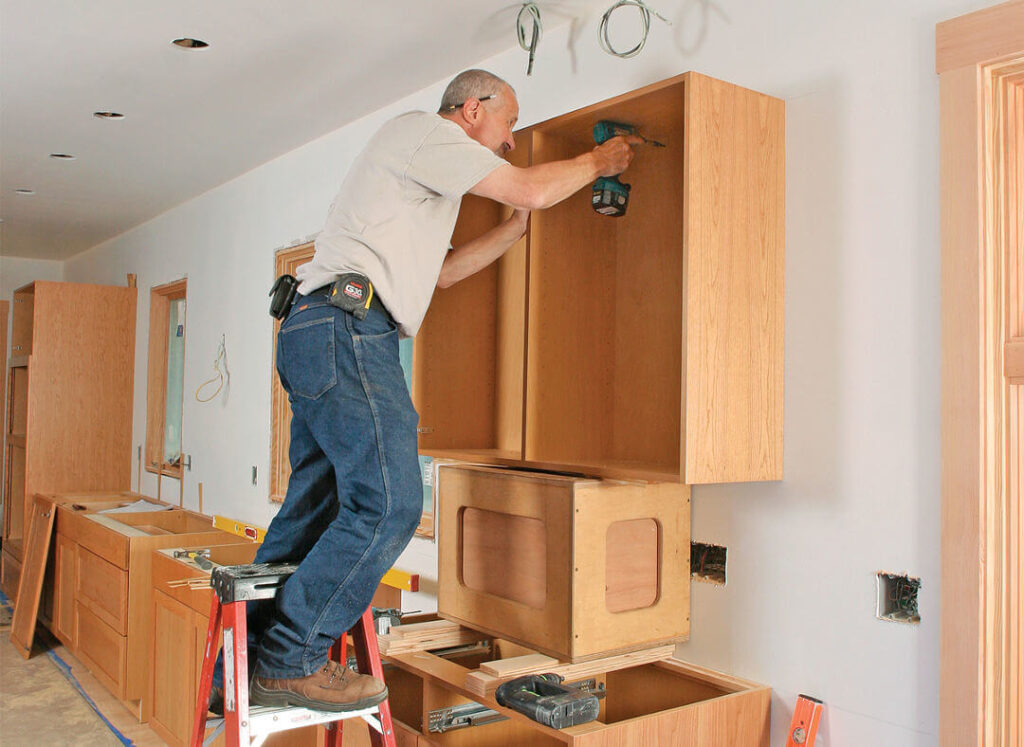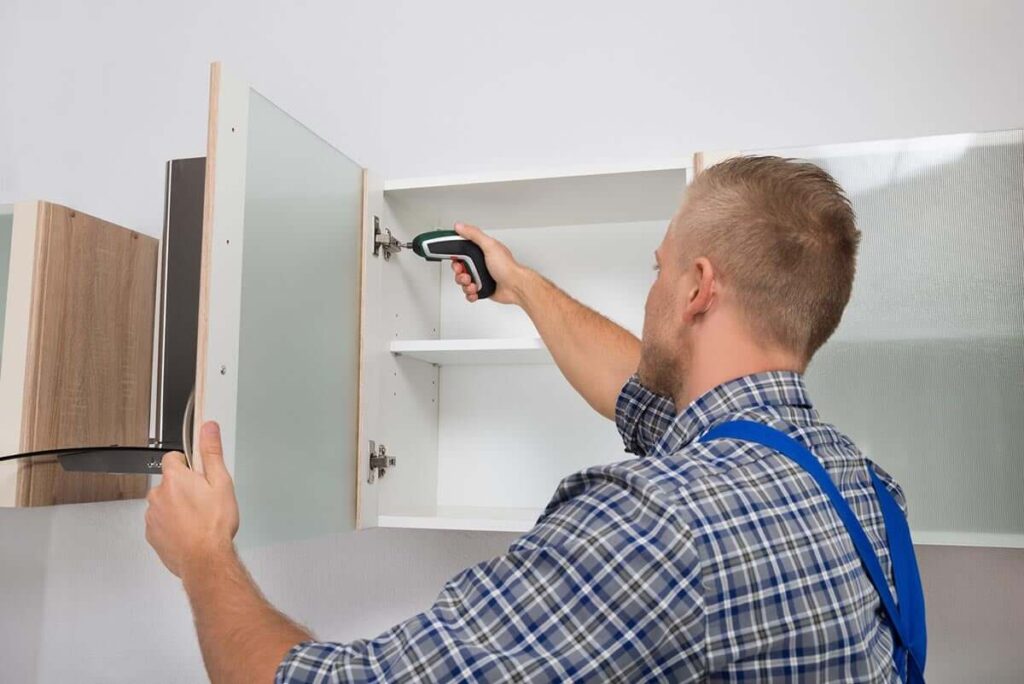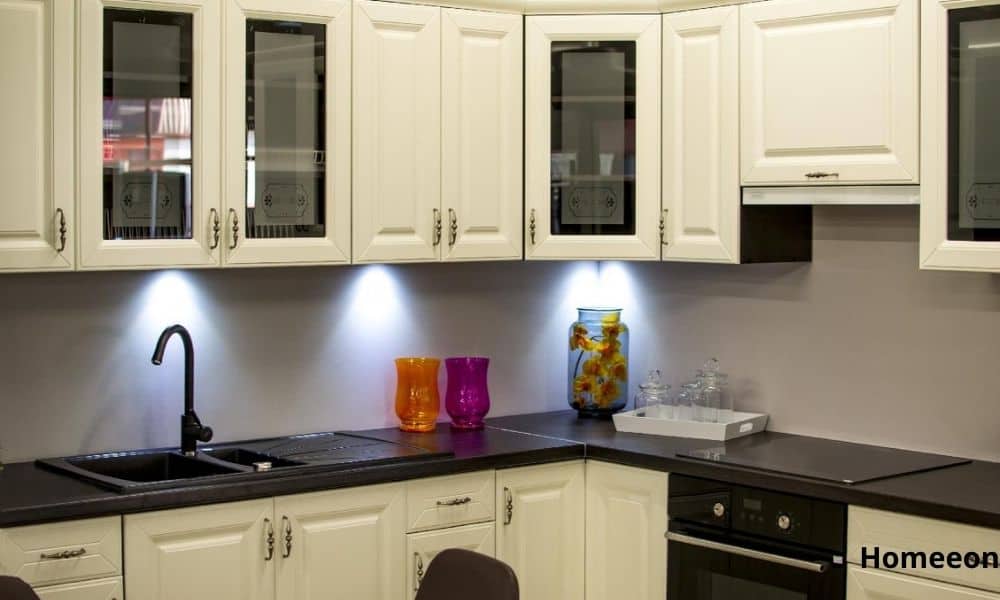Last Updated on August 2, 2023 By Emma W. Thomas
To hang cabinets on drywall:
- Use a stud finder to locate wall studs
- Secure cabinets to studs with screws or heavy-duty wall anchors
- Use a level to ensure proper alignment during installation for a sturdy and safe setup
What Is The Process Of Hanging Cabinets On Drywall?

To hang cabinets safely on a dry, wall the following things are needed: a stud finder, spackle, tape measure, a pencil, two-by-four lumber, hand or circular saw, deck screws, drill, and mounting screws. The process involves the following steps:
- Run the stud finder on the drywall to hang the cabinets and mark the positions lightly using a pencil.
- Using a tape measure, measure 19 ½ inches from the base cabinet’s top and mark the point lightly. Repeat this severally and connect all the marks to create a line on the drywall indicating the cabinet’s bottom position.
- Using either a hand or circular saw, cut two-by-four lumber equal to the lines marked on the drywall. The lumber will provide support to the cabinet during installation.
- Make markings at the back of the cabinet that will flush sit with the stud and make drill holes through the cabinet’s top and bottom hanging rail.
- Set the cabinet on the wall with the bottom edge sitting on the lumber.
- Open the cabinet doors and, using a screwdriver, drive some screws through the drilled holes on all the top and bottom hanging rails.
- Remove the support lumber from the drywall and patch the screw holes on the wall using a spackle. Before putting any items in the cabinets, one should check and ensure their stability.
It is advisable to hammer a nail into every studio’s location for verification as sometimes they are mistaken for plumbing or other hardware. Once one has found the first stud, the next one is mostly 16” off the center. Marking is important in this case as it helps prevent one from driving a screw through plumbing pipes or other utility service pipes.
What Tools you will Need to Hang Cabinets on Drywall
| Tool | Description |
|---|---|
| Stud Finder | This tool is essential for locating the framework inside the drywall where the cabinets will be securely mounted. |
| Drill | The drill will be used for creating pilot holes in the wall studs and for securing the cabinets with screws. |
| Measuring Tape | Precision is key when hanging cabinets. A measuring tape will ensure accurate positioning and alignment. |
| Level | To ensure the cabinets are straight and level, a good quality level tool is a must. |
| Pencil | A pencil is used for marking the positions of the cabinets on the wall. |
| Clamps | Clamps are used to hold the cabinets in place while they are being secured to the wall. |
| Screwdriver | A screwdriver, manual or electric, will be required to drive screws into the drilled holes. |
| Screws | Screws are the main connectors that secure the cabinet to the wall stud. Make sure to use sturdy and thick screws designed for cabinets. |
| Cabinet Shims | Shims are thin pieces of material that can help with any uneven areas in the wall to provide a properly aligned and secure fit for the cabinets. |
| Safety Goggles | To protect the eyes from potential dust or debris during the installation process, safety goggles are absolutely necessary. |
| Work Gloves | These will protect the user’s hands from certain risks like splinters or accidental cuts. |
Can One Hang Cabinets On Drywall Without Studs?
One can hang a cabinet on drywall without using studs as they do not exactly sit on it. Hanging a cabinet on drywall will require a drill and an anchor. One drills a hole, hammers in a wall anchor, and then add another large screw to offer the cabinet support. The only issue with this method is that there are wall anchor holes left on the drywall, and patching them leaves an undesired look.
Another option to hang cabinets on drywall is by using drywall anchors. These are tools that bridge the drywall and screws to create stability when hanging a heavy item on the wall. The screws are driven inside the anchor to keep them steady and in place. Drywall anchors are different depending on the shape, size, and heaviness of the cabinets.
How Can One Hang Cabinets On Drywall Using Drywall Anchors?
The following tools are needed to install cabinets on drywall using the drywall anchors; drywall anchors, a power drill, a hammer, and a cabinet jack. It is recommended that one get a complete drill since different anchors require specific drills to screw them into the wall. Different methods are used to install wall cabinets on drywall using the drywall anchors. They include;
Expansion Anchors Method
These anchors are like hollow plastic screws with outwards protruding wings. They are the most commonly used since they are readily available in most local stores. They are called expansion anchors because they expand upon ingesting a screw, making them tightly grip the drywall. They have a limited weight holding capacity of about 20 pounds as they are made of plastic. They are therefore limited to hanging only the small cabinets carrying light items. Such drywall anchors are used in bathrooms to hold light items such as toothbrushes and other light bathroom amenities. Their installation process includes:
- Marking drill points at the back of a cabinet to be installed
- Make similar markings on the drywall at the same distance.
- Drill holes on the walls with almost equal lengths to the anchor
- Place the drywall anchor on the drilled holes on the wall and hammer gently. There should be some resistance from the anchor as it seamlessly digs into the hole.
- Using the power drill, make holes in the cabinet where there are marks and insert screws from the cabinet’s interior. One should ensure that the endpoint protrudes to the cabinet’s backside for visibility.
- Make adjustments to the cabinet jack’s height and place the cabinet on them. One should ensure that anchor screws are aligned with the anchor holes.
- Finally, using the power drill, drive the screws into the anchor. Remove the cabinet jack and check the cabinet’s stability.
Threaded Anchors Method
This method uses anchors with a plastic body that is threaded. They resemble large screws known as Zipp-its. They have large threads that allow them to provide a strong and firm grip on the drywalls. They tend to have a better grip than expansion anchors, with their weight-holding capacity being up to 30 pounds. Their installation is pretty much similar the same as its uses.
Molly Bolt Methods
These are drywall anchors that use molly bolts strong and robust when lifting heavy items. Molly bolts are made of steel hence the ability to withstand a lot of pressure from cumbersome objects. For this reason, they can be used on any surface. To be used on cabinets, one needs to choose the right size molly bolt anchors to create a firm and strong grip on the drywall. Their installation involves the following procedure:
- Make drills of equal lengths on the wall and the cabinet to be installed as per the molly bolts’ diameter size to be used.
- Hammer the drywall anchor part in the drilled holes such that they fit in safely.
- One should ensure that every molly bolt with teeth is hammered entirely until its teeth grip the wall firmly.
- Take out the pre-installed screw in the molly bolt placed on the wall.
- Drill all the marked points on the cabinet and place them on the cabinet jack positioned so that the drilled holes lie over the molly bolts.
- Drive in the screws from inside the cabinet; remember to add the washer with the molly bolts for firmer grips.
- Remove the cabinet jack and confirm the stability of the hanging cabinets.
Molly bolts have metallic wings on one end that grips the drywall and increases hanging items such as cabinets. The wings must press against the drywall for the strongest grip, provided they are of the right size. They achieve this by having a larger gripping surface area than the other two methods, which involve plain screws.
Toggle Bolts Method

Toggle bolts are the most reliable drywall anchors for cabinet installation without using studs. They are strong and firm due to their toggle wings distributed over a large surface area. The wings have a spring load action, hence shutting them from the bottom side. Their installation procedure includes:
- Mark and drill holes on both the cabinets and the drywall large enough to allow passage of the folded toggle wings.
- Unscrew the toggle bolts wings and insert them into the cabinet drilled holes with their tail end protruding at the back.
- Mount the bolt wings on the screws placed on the cabinet holes.
- Place the cabinet on a jack and fix it appropriately on the wall. Insert the toggle bolts on the holes made on drywall, ensuring they slide in a while folded.
- Unfold the toggle wings on the other side of the wall to lock them in place.
- Tighten all the screws from inside the cabinet to fix it in position.
- Remove the jack and check the cabinet’s stability on the drywall.
Other than the above drywall anchors, more models are available in the markets with different shapes, sizes, and designs to hang cabinets and other drywall items. They are the best option, especially when studs are not available or inconvenient. They also have a wide range of uses compared to expansion anchors and threaded anchors due to their strong gripping nature.
Conclusion
Drywall is much softer and takes less time to drill through when installing a cabinet or other items. Depending on the drywall thickness, one can hang heavy cabinets on them without collapsing by either using studs or drywall anchors. The method to use is determined by various factors such as studs availability and convenience and the cabinet’s weight. With drywall, one must consider using extra support from studs or anchors as it is not easy compared to hanging items on plaster walls which are stronger.
References:
https://www.ehow.com/how_7440955_hang-cabinets-drywall.html
https://www.heritagecabinetry.biz/how-to-hang-cabinets-on-drywall/
Emma is a graduate of Domestic Science or Family and Consumer Sciences (Home Economics) from the University of Wisconsin. She has 7 years of experience Working with the strategic section of BestBuy and now writing full-time for Homeeon.
From Managing the Home, Interiors, Cleaning, and Exteriors to Gardening and everything about Making A Home Liveable – is her passion and this Homeeon is the result of this.
Emma loves decorating her home with the best stuff found online. She cares about quality over anything and writes reviews about them here in Homeeon. Get in touch with her over Pinterest.
Keep reading her blogs.

